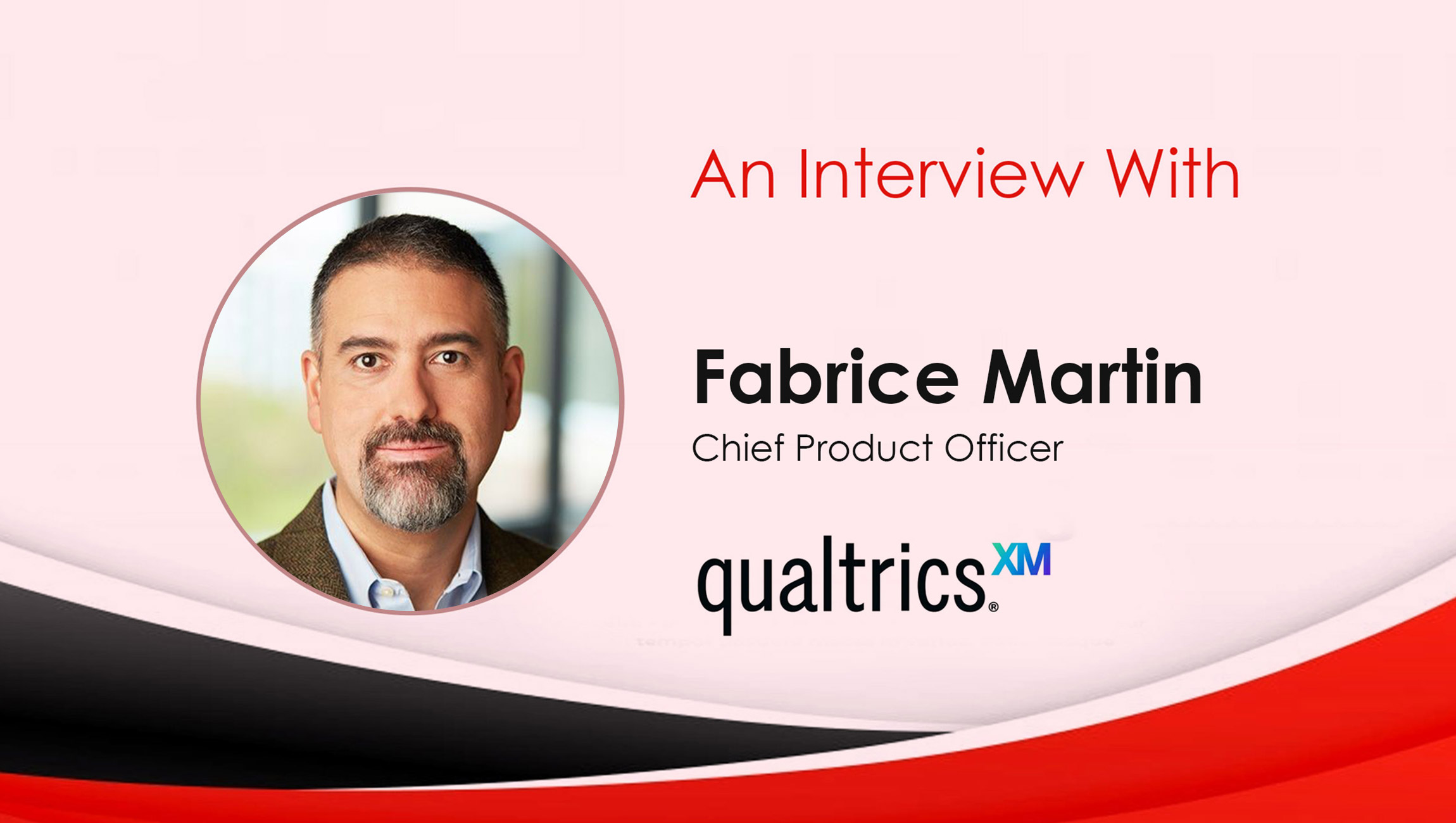Fabrice Martin, Chief Product Officer at Qualtrics discussed the various ways in which marketers today need to better understand and breakdown the end-to-end customer journey:
________
Welcome to this MarTech Series chat. Fabrice, you’ve had quite an interesting marketing journey leading product and marketing through the years. We’d love to hear a few highlights from your time in the B2B tech market and your role at Qualtrics since the acquisition of Clarabridge.
I’ve always been passionate about the intersection of analytics, business and technology. I’ve dedicated my career to developing, managing and promoting technologies that focus on helping businesses more fully understand users’ emotion, effort and intent to create more personal and empathetic experiences.
As the leader and creator of the experience management category, Qualtrics understands people today want to work for, and do business with, organizations whose actions demonstrate that they are listening and understanding their needs and wants.
Building deep and meaningful relationships requires listening, understanding and caring for each individual’s needs, and this must be done at-scale in a digital world. In my role, I get to take on that challenge using our technology to bring structure to unstructured data – the conversational data expressed on forums, websites, social media, chat, phone calls, and a host of other channels that, until now, have proved almost impossible for companies to truly understand at very large scales.
What current trends are you observing when it comes to conversational tools and experiences?
The volume of unstructured data in the world is growing rapidly and being increasingly relied on for decision-making purposes. More than 80% of an organization’s data is unstructured, according to IDC, yet only 18% of companies are able to take advantage of it.
The problem is that traditional sentiment analysis programs can’t keep pace with the amount of input coming in, whether from social posts, support calls or user reviews.
However, Natural Language Processing tools have advanced enough that the aperture for capturing experience data has opened on a wider scale in nearly every industry sector. For example, we are working with a major American healthcare and insurance company that has started to tap into and analyze unstructured customer feedback across channels such as calls, chats, agent care notes, emails, social media, and CRM data to better understand the key drivers behind their customer satisfaction scores. This helped them monitor issues as they arise and easily share insights with the relevant department, ensuring that the right teams are able to quickly take action.
Marketing Technology News: Qualtrics X4 is Now Live on XM+
What are some of the core, conversational features and analytics that marketers/brands need to be optimizing and focusing on more to drive better performance?
Today, companies must leverage technology to understand the qualitative markers of emotion– empathy, sentiment, effort – what we think of as the human “IT” factor that ultimately predicts and drives customer satisfaction, engagement and loyalty. Our text analysis tool is a great example of this. It utilizes both advanced text analytics and sentiment analysis to correctly capture relevant information, categorize feelings and transform it into actionable data.
For example, if a customer review states, “I loved that laptop, but this sale should have been easy – and it wasn’t,” a less advanced system would have difficulty weighing the love of the laptop against the difficulty of the sale.
Our technology allows us to break the sentence down more, specifically to extract meaning from text and provide a more accurate reading. While the phrase “loved the laptop” would garner a +3 score, “should have been easy and it wasn’t” would receive a -4. Instead of solely concluding the sentiment of the sentence was overall negative, the breakdown provides a more nuanced and precise judgment of the overall statement to our customers. Being able to spot and explain these nuances and subtleties is crucial because it leads to more reliable readings and thus better results.
How can marketers today drive deeper personalization with these technologies, and what are some of the top factors they should keep in mind and/or avoid doing?
To create deeper personalization, companies need to both hear and understand what is being said, and how. Think of it as mapping a customer’s genetic make-up. By unifying explicitly collected feedback from things like surveys with the qualitative and implicit markers generated during conversations, customer journeys, in person interactions, and online behaviors, marketers can create an effective plan, personalized for an audience or ideally each individual.
The way we help our customers tackle this is with a connected, intelligent system that stores ALL their customer profile data. It captures and stores all interaction types, from the things people tell businesses directly, to signals in unstructured data like social media posts, reviews, conversations and more. This combination of data helps predict customer changes, intentions, outcomes, risks, and opportunities. Brands can identify customers and prospects for curation, for deepening relationships, for making offers, for suggesting next best actions, not just based on a single, recent interaction, but based on the full knowledge of past customer interactions, feedback and conversations.
How can marketers optimize use of unstructured data in this workflow to ensure they grab the most relevant insights to further impact?
A company may have 100M customers and be operating at incredible scale. Yet sometimes the most interesting or insightful feedback is made by a small set of individuals. With the right tools, every chat, post, review, call, or comment can be automatically analyzed to identify the topic, sentiment, emotion, intensity, level of empathy and effort, as well as their reason for contact and intent.
Marketers need to make sure they have the right technology in place that can help teams make sense of the data – know which topics or trends are leading indicators of a positive or negative experience, and know how to route issues to the right people who can act on these insights
The final hurdle is how you connect the customer IDs, needs, preferences, and experience markers to your systems of record. Things like CRM and marketing automation tools, eCommerce sites, content management platforms, and the contact center platforms that power the interactions between customers and companies. Creating that link allows you to tailor, and tune offers, preferences, and experiences and generate more relevance, more efficiency, and ultimately, more loyalty.
Marketing Technology News: MarTech Interview with Ruoting Sun, Vice President, Product Marketing at Recharge Payments
We’d love to hear a few predictions you have in mind for the future of conversational technologies and martech as a segment?
We will see continued advancements in Natural Language Understanding capabilities and AI. The ability to understand meaning and intent across multiple languages (or even Emoji’s), across multiple topics and with a great degree of accuracy, is incredibly complex but is becoming more and more achievable.
We will start to see wider use of intelligent agents that augment the work of marketers. These digital agents will be able to recommend and run analyses on a variety of topics, pulling together customized reports and visual representations of data which will facilitate a more transparent and accurate understanding of the customer landscape and customer journey.
Do you have any last thoughts and/or predictions for 2022 before we wrap up?
As privacy concerns continue to escalate globally, customers will demand more transparency in how their data is used. The continuous desire to protect personal data will drive higher requirements on data sovereignty and privacy. This will have a number of implications. It places a premium on the value of experience data that is freely given by customers. This also has massive implications on how organizations – big and small – will choose platforms who conform to these privacy and data sovereignty requirements
The tsunami of unstructured data will continue to grow every day. Being able to wield, capture, comprehend and act on this valuable information will be key for driving growth now and in the future.
Listening to what consumers want, anticipating changing needs and taking steps to meet those expectations are paramount. With the right tools and partners, greater access to data shouldn’t feel like a burden – it’s a tremendous opportunity that many companies are only just beginning to explore.
Marketing Technology News: Social Media is Changing – Don’t Let Your Multi-Location Business Miss Out
Qualtrics, a leader and creator of the Experience Management (XM) category, is changing the way organizations manage and improve the four core experiences of business—customer, employee, product and brand. Over 16,750 organizations around the world use Qualtrics to listen, understand and take action on experience data (X-data™)—the beliefs, emotions and intentions that tell you why things are happening, and what to do about it. The Qualtrics XM Platform™ is a system of action that helps businesses attract customers who stay longer and buy more, engage employees who build a positive culture, develop breakthrough products people love and build a brand people are passionate about.
Fabrice is the Qualtrics Chief Product Officer – Discover, Customer Care, and is responsible for the vision, roadmap and go-to-market strategy for Qualtrics XM Discover and Customer Care and Frontline buyers. Prior to Qualtrics, he was the Chief Product Officer at Clarabridge. Fabrice brings more than two decades of experience launching new products and business applications focused on solving large, complex analytical problems and delivering valuable insights.
Missed The Latest Episode of The SalesStar Podcast? Have a quick listen here!
Episode 120: The Future of Customer Success with Guy Nirpaz, Founder and CEO at Totango
Episode 119: Sales Trends that Generate Better ROI: with Scott Smyth, VP Global Sales at HG Insights
Episode 118: The Power of Chatbots in B2B Tech with Chris Maeda, co-founder and CTO at Botco.ai












